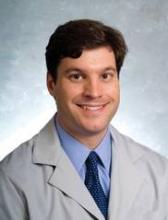The annual meeting of the American Society of Human Genetics was held in November in San Francisco, and it highlighted many practical applications of next-generation sequencing technology in the clinic. For those who follow the "Genetics in Your Practice" column routinely, you may recall a prior column from last year ("Personal Genome Analysis in the Clinic") that focused on the announcement of the availability of personal genome analysis via sequencing of the entire exome, clinically, in advance of last year’s ASHG meeting.
One year later, where do we stand with the deployment of next-generation sequencing (NGS) technology clinically, and what is the potential impact for the internist?
NGS technology is gaining traction within the clinical domain, including whole exome sequencing. Whole exome sequencing encompasses sequencing every exon of every known gene (approximately 22,000 genes), nucleotide by nucleotide. In essence, this is a massive way to "spell check" what are thought to be the most functionally important regions of the human genome. By my unofficial review, at least 10 laboratories (a mixture of commercial and academic medical centers) are offering this service clinically.
One of the early academic laboratories offering clinical exome sequencing reports that it has received more than 600 patient samples for whole exome sequencing – and in the last few months, it has been averaging close to 200 samples per month.
This is an astonishing volume for such expansive testing. And the volume appears to be increasing, based on comments and informal reports from laboratories offering this service, now being referred to as the "diagnostic exome."
Many cases are pediatric, seeking to end the "diagnostic odyssey" for evaluating rare and unusual clinical presentations. But 15%-20% of submitted samples are from the adult patient population. It is expected that this number will increase, especially when you consider the prospect of applying whole exome sequencing to tumor samples to personalize cancer treatment in patients with metastatic disease who have failed conventional chemotherapy.
What can we expect to find if a patient has his or her whole exome sequenced?
Depending on the clinical scenario, on average of 0-2 deleterious mutations are found in a known gene with a disease associated with it, regardless of whether the particular gene is related to the condition that originally prompted the patient to seek testing.
On average, there will be at least one gene with a deleterious mutation that’s linked to a condition that has established guidelines for management or screening. One example would be a mutation that causes Lynch syndrome (increased risk for colon and uterine cancers). Typically, carrier status for one gene will be identified (e.g., cystic fibrosis), as well as three gene alterations that have pharmacogenetic implications.
This type of information is usually noted on a "first tier" or "focused" report by the clinical lab to help the clinician manage the potential amount of information garnered by whole exome sequencing.
However, many labs offer an "expanded" or "second tier" report that goes beyond the initial reported information. On average, this expanded report will identify 17-25 more deleterious mutations in genes for which the clinical information may be limited or for which there may not be a known disease association. This is a challenge for the managing physician, both in terms of explaining these findings and in how to follow up on new developments.
By performing whole exome sequencing, we will "find something," as most people will have at least one clinically important disease-causing or risk-associated finding. Evidence of this was presented across many different medical disciplines at this year’s ASHG meeting.
For example, exome sequencing was applied to 45 families with a strong history of breast cancer and who did not have a mutation in a previously identified breast cancer risk gene such as BRCA1 and BRCA2. This analysis identified eight new breast cancer risk genes (ATR, BAP1, CHEK1, GEN1, KANK4, OBSL1, RAD51B, and TP53BP1), some of which are now included on clinically available cancer risk panels (C.H. Spurrell et al., ASHG abstract #26).
Findings were not limited to cancer risk. Another study at the meeting reported a 25% success rate for establishing a diagnosis in nonsyndromic hearing loss with adult onset (E. Shearer et al., ASHG abstract #60). Typically, this is not an area of high yield for identifying a genetic cause, and thus it illustrates the impact of NGS technology.
Ultimately, the goal is to move beyond diagnosis and change the course of disease. One likely area in which internists will see their practices impacted is the choice of cancer chemotherapy.



